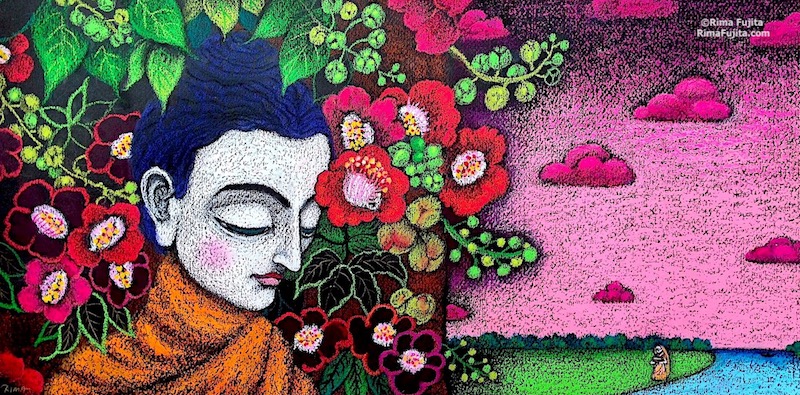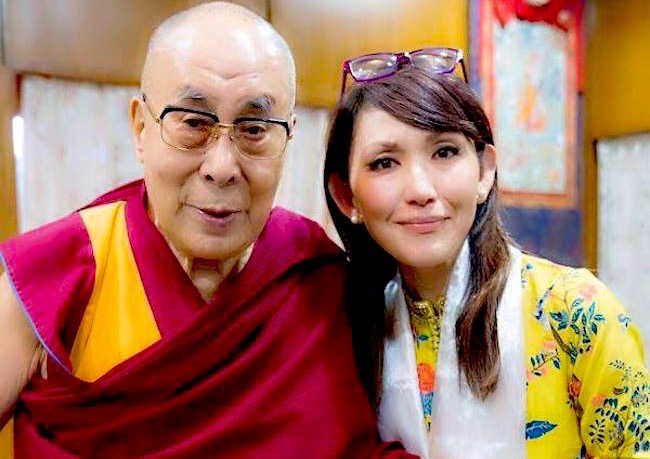Rima with His Holiness the Dalai Lama. ©Tenzin Choejor/OHHDL
An enlightened, ineffably wise face deep in contemplation of the bottomless realities of the cosmos. Yet the colours are so vibrant as to have an almost childlike, playful quality. This vibrant and vivid aesthetic is Rima Fujita’s instantly recognizable artistic style, which has captured the attention of artists, Buddhists, and art-lovers around the world as a fresh and contemporary take on the notion of Buddhist art. This piece is to be auctioned at a live event at New York’s prestigious Gallery Eight on 7 November, from six o’clock to nine o’clock in the evening (it is also available for bidding online)
“This piece I’ve donated is an original painting from my picture book The Day The Buddha Woke Up (Wisdom Publications), which was published last year. It depicts the iconic scene where Siddhartha realizes the ‘Middle Way path’ after many months of self-starvation, and eats a bowl of rice soup offered by Sujata, a village girl. Then, Siddhartha would go into a deep meditation under the Bodhi tree in Bodh Gaya to reach Nirvana.
“Since this scene is so special I was keeping this painting for myself (which is very rare as I normally sell most of my pieces), but when Students for a Free Tibet requested me to donate a painting I thought it would be important to let this painting go for a good cause. Here is why. When I went on the Buddhist pilgrimage in India and Nepal a few years ago one of my teachers, a Tibetan geshe came to meet me in Bodh Gaya. And he told me something that never left my heart. As I was crying out of joy to be in Bodh Gaya, one of the most magical places I’d ever been in my life, he said, ‘Rima, you must share this joy with others. Think of thousands of people who wish to be here, but cannot. You cannot keep this extraordinary experience to yourself. You must share. Remember that.'”
Many of Rima’s works are not Buddhist-themed, but she enjoys painting Buddha and deities deeply. “When I feel low I often draw Buddha heads, and I begin to feel calm and peaceful. However, my work ethic is strongly based on Buddhism and Bushido, as my ancestors were the last samurais. I try to respect the people I work with, the work process and methods. I keep my pride and honor in what I do.”
Rima and India share a deep bond, but her bond with Tibetan culture, people, and art has also shaped her life in a distinct and unique direction. She grew up in a non-religious family, and had no interest in Buddhism until she encountered several Tibetan monks in New York who introduced her to Tibetan Buddhism. “That completely changed my image of Buddhism,” she said. “In Japan where I lived until I was 15, I had a rather negative image of Buddhism as I witnessed so much corruption in the Buddhist world there. However, when I discovered Tibetan Buddhism it seemed more authentic, generally speaking, of course.”

As she began studying Tibetan Buddhism, she began dreaming about Buddhist images and would often have various deities visit her in my dreams to convey messages. “I feel so happy when I see His Holiness the Dalai Lama in my dreams often, too,” she related to me. “Dharamsala is my spiritual home because he lives there. He is my root guru. I’ve visited Dharamsala many times, and when I arrive there I always feel that I’ve come home. When I return to the USA I miss Dharamsala so much and I often weep. Everything inspires me in Dharamsala—the stunning Himalayan mountains, the crisp air, the monasteries, the beautiful energy, and my dear Tibetan friends.”
She had a very lucky start as a young artist in New York. During her twenties, her art was already selling very well—an incredible achievement for someone who was only just starting out in her career. Yet there was a dark side. “I was making a very good living, but I didn’t like the commercial art world. I was abused and sexually harassed by famous art dealers. They stole my works and often I never got paid for my art that were sold. I witnessed so much greed and dishonesty in the commercial art industry, and I wasn’t happy despite my success. Then, one night, I heard a voice in my dream and it said, ‘You must help Tibet now!’ I realized that art was not a goal, but only a tool to serve others; a tool to make this world a better place, to be the voice for the voiceless, to help humanity.”
While Rima continued to exhibit and sell art, she felt liberated in discovering a new purpose behind her work. She established Books for Children, an organization that creates picture books for the Tibetan refugee children in order to help preserve their unique culture and language. “I’ve made 7 picture books and have donated more than 15,000 books to the community-in-exile. They are all written in Tibetan, English and Japanese, and many of them have forewords written by His Holiness.” She donates her book royalties to refugees.
“Art is a tool to serve humanity,” she concludes with conviction. “It’s my responsibility to create art to raise awareness of important issues in the world. Tibet is my life-time commitment, and I will keep supporting Tibetans in any way I can.”


[…] Rima Fujita: Art and Action […]
Beautiful art and soul. Thank you Rima for your contribution to make this world a better place.
Namaste.
[…] Visuals of Compassion: Artist Rima Fujita on her new exhibit, “Karuna”Rima Fujita: Art and Action […]